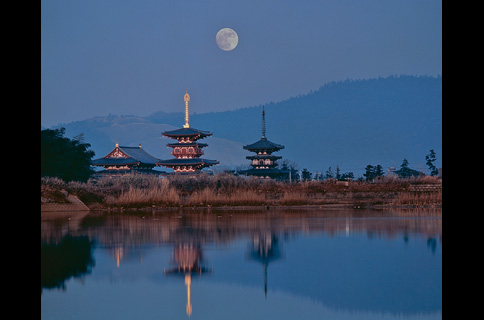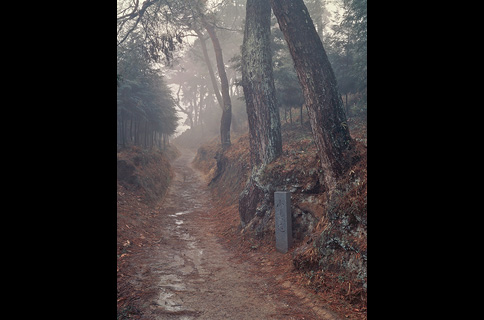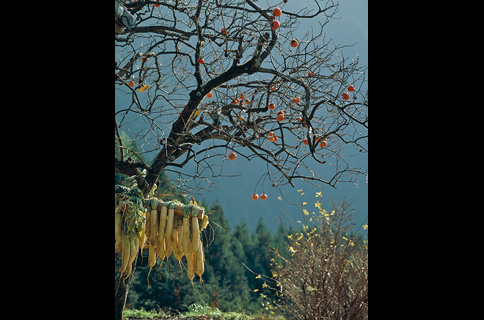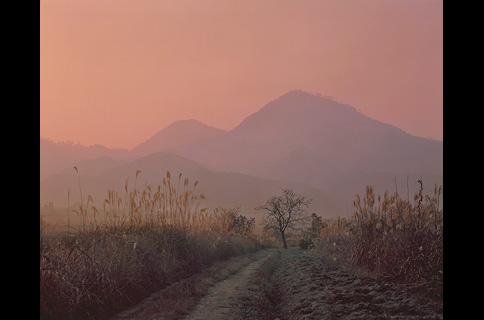- Home
- Exhibitions & Events
- Cultural Landscape of Japan — Nara Yamatoji A photo exhibition by Taikichi Irie
Photo History Museum FUJIFILM SQUARE
Cultural Landscape of Japan — Nara Yamatoji
A photo exhibition by Taikichi Irie
The Photo History Museum at FUJIFILM SQUARE is pleased to announce the photo exhibition “Cultural Landscape of Japan — the Nara Yamatoji,” a collection of photographs by renowned photographer Taikichi Irie that capture the essential beauty of Nara. The exhibition runs from January 4 - March 22, 2017.
Taikichi Irie was born Nara prefecture in 1905, and from an early age set his heart on becoming an artist. At the age of 17, his brother gave him a camera which triggered his lifelong love of photography. At the age of 26, he set up a photography shop, Kogeisha, in Osaka, but the shop suffered heavy damage during US bombing raids in the Second World War, and in 1945 he and his wife returned to Irie's hometown in Nara. The surrounding landscape of his Nara home combined scenic beauty with ancient temples — exuding a sense of peacefulness and tranquility, and evoking images of the area's distant history. This was the perfect remedy for the trauma Irie had experienced in Osaka. However, immediately after the end of the war, a rumor circulated that the US occupation forces were planning to round up all the ancient Buddhist statuary in Nara and ship them to the US. Aware that these statues were a key element in the make-up of the Japanese psyche, Irie decided that the least he could do was to take photographic images that captured the essence of Nara's Buddhist statues. He then embarked on a journey around Nara's Yamatoji area — that would eventually take half a century — to capture images of Nara's ancient temples and natural beauty. The Yamatoji refers to the area that extends south from Kyoto to modern-day Nara prefecture. This is the area where the people of Japan in the Asuka (538-710AD) and the Tenpyo (729-749AD) periods blended their existing belief and practice of nature worship with Buddhist ideology. Irie set about his self-appointed mission of capturing the quintessential soul of the Nara plains to appeal to a wide Japanese audience while also seeking to pay homage to those countless generations who had come before.
This exhibition features a collection of photos selected from the period after 1964 when Irie turned to color photography to express the beauty of the Nara Yamatoji area in delicate color tones. Among the featured images are “Ikaruga-no-sato sunset” (circa 1980) which portrays the Horyu-ji temple silhouetted against an exquisite early evening landscape, and “The road to Mt. Nijo” (circa 1968) which depicts a mist enshrouding the rural landscape encountered on the road to Mt. Nijo. When he first turned his hand to color photography, Irie experienced some initial teething problems, but he was able to develop his own style of restrained color, which came to be known as the Irie-style and which informed the later images that won him wide acclaim. His works serve as a vivid reminder of the essence that shaped the mindset of those who lived in ancient times, and awake a dormant longing in the viewer to return to one's own roots. We very much hope that visitors to the exhibition will enjoy the suggestive colors that make up Irie's view of the world.
Profile — Taikichi Irie (1905 - 1992)
Born in 1905 in the city of Nara, Irie dreamed of becoming an artist, despite the opposition of this family. At the age of 17, he received a camera from his brother, sparking his lifelong interest in photography. In 1931, he opened his own photography shop in the Unagidani district of Osaka called Kogeisha. The shop doubled as a living quarter, and during an air raid in March 1945, his shop was destroyed. Irie decided to return to the family home in Nara. Immediately after the conclusion of the war, Irie heard a rumor that the US occupation forces were planning to ship all the famous Buddhist statues in Nara to the US, and he decided to capture photographic images of the statues before they disappeared forever. Later, Irie decided to take photos of the Buddhist statuary, landscapes and traditional ceremonies of the Yamatoji area. In 1964, he turned to color photography, and his Yamatoji photos began to gain global attention. He published several photographic collections including Yamatoiji (Tokyo Sogen Co., Ltd. 1958) and Irie Taikichi — Complete Works (Shueisha, 1981). He passed away on January 16, 1992 at the age of 86. In April of the same year, the Nara City Museum of Photography opened, which later changed its name to the Irie Taikichi Memorial Museum of Photography Nara City. In March 2015, Irie's former residence was opened in the Suimoncho district of Nara City.
| Name of exhibition | Cultural Landscape of Japan — Nara Yamatoji A photo exhibition by Taikichi Irie |
|---|---|
| Period | January 4 - March 22, 2017 |
| Opening Hours | Open everyday from 10:00 - 19:00 (last entry 18:50) |
| Venue | Photo History Museum, FUJIFILM SQUARE |
| Number of exhibits | 24 |
| Admissions | Entry free |
| Organized by | FUJIFILM Corporation |
| In cooperation with | The Irie Taikichi Memorial Museum of Photography Nara City |
| Supported by | Minato City Board of Education |
| Planning by | Photo Classic, Inc. |
In 2016, the Photo History Museum was formally approved by the Association for Corporate Support of the Arts for its “contributions to society through the promotion of arts and culture” and was permitted to use the official “This is MECENAT 2016” mark.





